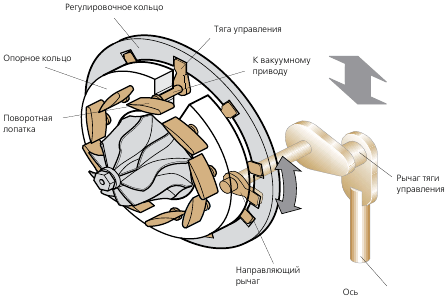
Fixed geometry vs variable geometry turbocharger - what's the difference?
Often when describing engines, the term "variable turbocharger geometry" is used. How is it different from a constant and what are its advantages and disadvantages?
A turbocharger is a device that has been widely used in diesel engines since the 80s, increasing torque and power and positively affecting fuel consumption. It was thanks to the turbocharger that diesels were no longer perceived as dirty working machines. In gasoline engines, they began to have the same task and appeared more frequently in the 90s, over time they gained popularity, and after 2010 they became as common in gasoline engines as they were in the 80s and 90s. in diesels.
How does a turbocharger work?
A turbocharger consists of a turbine and a compressor mounted on a common shaft and in one housing divided into two almost double sides. The turbine is driven by exhaust gases from the exhaust manifold, and the compressor, which rotates on the same rotor with the turbine and is driven by it, creates air pressure, the so-called. replenishment. It then enters the intake manifold and combustion chambers. The higher the exhaust gas pressure (higher engine speed), the higher the compression pressure.
The main problem with turbochargers lies precisely in this fact, because without an appropriate exhaust gas velocity, there will be no proper pressure for compressing the air entering the engine. Supercharging requires a certain amount of exhaust gas from an engine at a certain speed - without proper exhaust load, there is no proper boost, so supercharged engines at low rpm are extremely weak.
To minimize this undesirable phenomenon, a turbocharger with the correct dimensions for the given engine should be used. The smaller one (smaller diameter rotor) “spins” faster because it creates less drag (less inertia), but it gives less air, and therefore will not generate much boost, i.e. power. The larger the turbine, the more efficient it is, but it requires more exhaust gas load and more time to "spin up". This time is called turbo lag or lag. Therefore, it makes sense to use a small turbocharger for a small engine (up to about 2 liters) and a large one for a larger engine. However, larger ones still have a lag problem, so Large engines typically use bi-turbo and twin-turbo systems.
Gasoline with direct injection - why turbo?
Variable geometry - the solution to the turbo lag problem
The most effective way to reduce turbo lag is to use a variable geometry turbine. Movable vanes, called vanes, change their position (angle of inclination) and thereby give a variable shape to the flow of exhaust gases that hits the unchanging turbine blades. Depending on the pressure of the exhaust gases, the blades are set at a greater or lesser angle, which accelerates the rotation of the rotor even at lower exhaust gas pressure, and at higher exhaust gas pressure, the turbocharger operates as a conventional one without variable geometry. The rudders are mounted with a pneumatic or electronic drive. Variable turbine geometry was initially used almost exclusively in diesel engines., but it is now also increasingly used by gasoline.
The effect of variable geometry is more smooth acceleration from low revs and the absence of a noticeable moment of “turning on the turbo”. As a rule, diesel engines with a constant turbine geometry accelerate to about 2000 rpm much faster. If the turbo has a variable geometry, they can accelerate smoothly and clearly from about 1700-1800 rpm.
The variable geometry of the turbocharger seems to have some pluses, but this is not always the case. Above all the service life of such turbines is lower. Carbon deposits on the steering wheels can block them so that the engine in the high or low range does not have its power. Worse, variable geometry turbochargers are more difficult to regenerate, which is more expensive. Sometimes complete regeneration is not even possible.

